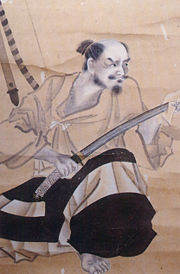
Baba Nobuharu
Encyclopedia

, also known as , was a samurai
Samurai
is the term for the military nobility of pre-industrial Japan. According to translator William Scott Wilson: "In Chinese, the character 侍 was originally a verb meaning to wait upon or accompany a person in the upper ranks of society, and this is also true of the original term in Japanese, saburau...
of Japan
Japan
Japan is an island nation in East Asia. Located in the Pacific Ocean, it lies to the east of the Sea of Japan, China, North Korea, South Korea and Russia, stretching from the Sea of Okhotsk in the north to the East China Sea and Taiwan in the south...
's Sengoku period
Sengoku period
The or Warring States period in Japanese history was a time of social upheaval, political intrigue, and nearly constant military conflict that lasted roughly from the middle of the 15th century to the beginning of the 17th century. The name "Sengoku" was adopted by Japanese historians in reference...
and one of Takeda Shingen
Takeda Shingen
, of Kai Province, was a preeminent daimyo in feudal Japan with exceptional military prestige in the late stage of the Sengoku period.-Name:Shingen was called "Tarō" or "Katsuchiyo" during his childhood...
's so-called "Twenty-Four Generals
Twenty-Four Generals of Takeda Shingen
The Twenty-Four Generals were just one of many historically famous groupings of battle commanders from Japan's Sengoku Period. These Twenty-Four were the most trusted commanders of the armies of Takeda Shingen...
"; they were his most trusted commanders. Baba fought at the battles of Mikatagahara
Battle of Mikatagahara
The ' was one of the most famous battles of Takeda Shingen's campaigns, and one of the best demonstrations of his cavalry-based tactics.-Background:...
and Nagashino
Battle of Nagashino
The ' took place in 1575 near Nagashino Castle on the plain of Shitaragahara in the Mikawa province of Japan. Forces under Takeda Katsuyori had besieged the castle since the 17th of June; Okudaira Sadamasa , a Tokugawa vassal, commanded the defending force...
, where he led the vanguard of Takeda Katsuyori
Takeda Katsuyori
was a Japanese daimyo of the Sengoku Period, who was famed as the head of the Takeda clan and the successor to the legendary warlord Takeda Shingen. He was the son of Shingen by the , the daughter of Suwa Yorishige...
's right-wing.
When Takeda Shingen took Fukashi castle
Siege of Fukashi
The 1549 siege of Fukashi was executed by Takeda Shingen during his campaign to take Shinano province. Fukashi was one of several minor fortresses controlled by Ogasawara Nagatoki and lost to Shingen....
(now Matsumoto Castle
Matsumoto Castle
, also known as the because of its black exterior, is one of Japan's premier historic castles. It is located in the city of Matsumoto, in Nagano Prefecture and is within easy reach of Tokyo by road or rail....
) in 1550, he entrusted it to Baba. At Mikatagahara in 1573, he led the vanguard in chasing Tokugawa Ieyasu
Tokugawa Ieyasu
was the founder and first shogun of the Tokugawa shogunate of Japan , which ruled from the Battle of Sekigahara in 1600 until the Meiji Restoration in 1868. Ieyasu seized power in 1600, received appointment as shogun in 1603, abdicated from office in 1605, but...
's army back to their Hamamatsu fortress; upon seeing the gates open and braziers lit, Baba mistakenly suspected a trap, and did not press the fleeing army further. It was at Nagashino that Baba was killed, three years later, as two samurai attacked him simultaneously with their spears, taking off his head.
The Koyo Gunkan
Koyo Gunkan
The ' is a record of the military exploits of the Takeda family, compiled largely by the Takeda vassal Kōsaka Danjō Masanobu, and completed in 1616 by Obata Kagenori...
states that Shingen often consulted Nobuharu on important matters. Prior to Nagashino, Nobuharu was reputed to have fought in 21 battles without receiving a single wound.

